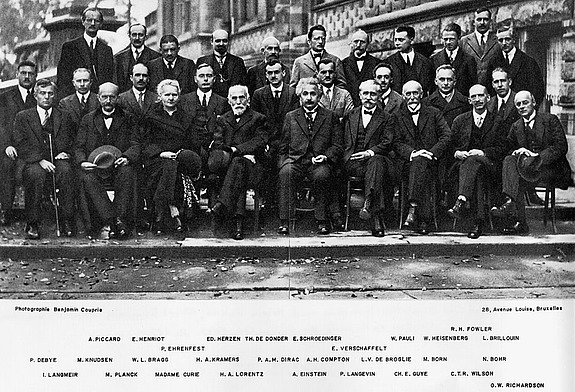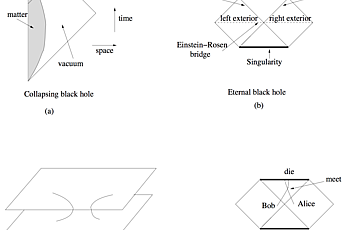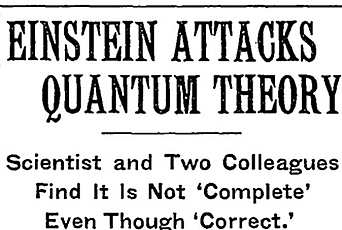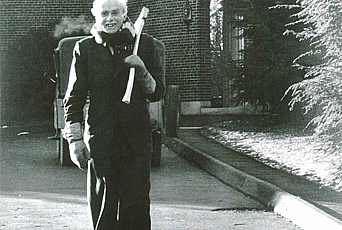A Quantum Story

In the two years I spent at the Institute, 1957–59, I had the opportunity of meeting two of the founders of the quantum theory—Niels Bohr and Paul Dirac. In the case of Bohr, perhaps “meeting” overstates the case. He was a Member in the spring of 1958 and Oppenheimer, who had known him since the 1920s and who had a feeling of adulation for him, decided that a fitting thing to do was to have a sort of seminar in which the physicists would trot out their wares with Bohr looking on and possibly commenting. As it happened, I had had a brief collaboration with T. D. Lee and C. N. Yang, who had won the Nobel Prize that fall. They had better things to tell Bohr than our modest work, so I was the designated spokesman. I was given ten minutes and took about three. After which Bohr commented, “Very interesting,” which meant he did not think so. If he had had any real interest, he would have engaged in a Socratic dialogue, which would have proceeded until he was satisfied. There is a famous story concerning Erwin Schrödinger—with whom I later spent an afternoon in Vienna—arriving in Copenhagen after having created his version of the quantum theory. Bohr disagreed with some of what Schrödinger was saying and pursued him into his bedroom where the now sick Schrödinger had taken refuge.
On a visit to the Institute ten years earlier, Bohr had written his wonderful account of his discussions with Einstein about the theory. Bohr found writing incredibly difficult and always had an amanuensis who acted as a sounding board. In this case, it was Abraham Pais who told the following story. Einstein had given Bohr his office for the visit and was in the adjoining smaller office of his assistant. Where the assistant had gone is not recorded. Bohr was facing away from the door and saying, “Einstein, Einstein” several times. As if summoned by a genie, Einstein stealthy came into the office. Before Bohr could turn around, Einstein helped himself to some of Bohr’s pipe tobacco. When Bohr did turn around, Einstein explained that his doctor had ordered him not to “buy” any more tobacco, but there was no injunction against his “stealing” some.
My encounters with Dirac were somewhat more extensive. In the 1958–59 terms, he had come to the Institute. On some evenings when his wife—whom he sometimes introduced as “Wigner’s sister” since, in fact, she was the sister of Eugene Wigner—was out of town, he would eat his dinner with the rest of the bachelors in the Institute cafeteria. Most of us were too shy to ask him anything, but not John Sakurai, who was visiting from Cornell. We had been discussing scientific collaboration when Sakurai asked Dirac if he had ever collaborated with anyone. Dirac replied, “The really good ideas are had by only one person,” which put an end to that.
In 1962–63, Dirac was again visiting the Institute. By this time, I had begun to write scientific profiles for the New Yorker and had decided that Dirac would be a very good subject. I had even conceived a modus operandi. I knew from his previous visit that Dirac spent much time in the woods behind the Institute clearing brush or chopping trees. To what end, I never found out. I thought I would join him in this enterprise and discuss his life and times as we chopped. I arranged to visit him in his office in Princeton. The one thing that stood out in that encounter was his insistence that Heisenberg be credited for the invention of quantum theory. I found this a little odd since Heisenberg’s role was so well-known. But looking back I think more was involved. Many physicists had never forgiven Heisenberg for his role during the war. When he came to Cambridge to give a talk, which I attended, some of them refused to shake his hand. I think that Dirac was signaling that he did forgive Heisenberg. In any event, after my visit, Dirac put a stop to the project. At the time, I was disappointed, but looking back I am grateful. I would never have found out enough about him to write a good profile.
In 1929, Dirac famously said of the then recently invented quantum theory, “The underlying physical laws necessary for the mathematical theory of a large part of physics and the whole of chemistry are thus completely known, and the difficulty is only that the exact application of these laws leads to equations much too complicated to be soluble.” Now, eight decades later, one would add biology, astrophysics, cosmology, and computing to the list and note that computers have made possible approximate solutions to equations that would have been beyond the capacities of the physicists at that time to deal with. Nonetheless, there were reservations about the theory, especially by Einstein, from the beginning. In 1925, he wrote to his friend from the patent office, Michele Besso (my translation), “The most interesting recent delivery by the theorists is the theory of Heisenberg-Born-Jordan concerning the quantum situation. A veritable sorcerers’ calculation in which there appear infinite determinants (matrices) in the place of Cartesian coordinates. This is sufficiently ingenious and protected by its great complexity, to be immune to any proof of its falsity.” Schrödinger’s wave mechanical version of the theory had not yet been discovered. When it was, Einstein was initially enthusiastic until Max Born argued that the Schrödinger waves were waves of probability. This inspired Einstein to write Born in 1926,
“Quantum mechanics is certainly imposing. But an inner voice tells me that it is not yet the real thing. The theory says a lot, but does not really bring us any closer to the secret of the ‘old one.’ I, at any rate, am convinced that He does not throw dice.”
This particular objection to the theory soon was superseded by others. By the 1930s, something called the “Copenhagen interpretation” was widely accepted and Einstein disagreed with most of it. The best, simple summary of this interpretation (which was never called that in Copenhagen—indeed, people like Léon Rosenfeld, who was Bohr’s amanuensis in the 1930s, insisted that the quantum theory was not like a piece of music that needed an interpretation) was given by John Wheeler in terms of his three baseball umpires.
Number 1: I calls ’em like I see ’em.
Number 2: I calls ’em the way they are.
Number 3: They ain’t nothing till I calls ’em.
Einstein is probably best described by the second umpire and Bohr by the third. Pais once walked Einstein home from his office when the moon rose. Einstein asked if Pais really believed that the moon was not there when no one looked at it. Esse est percipi—to be is to be perceived—as Bishop Berkeley famously said. The quantum umpire would argue that in some sense observables do not exist until they are observed. This is what Einstein found intolerable. In 1935, two years after he had joined the Institute, he coauthored a paper with Boris Podolsky and Nathan Rosen , “Can Quantum-Mechanical Description of Physical Reality Be Considered Complete,” [generally referred to as EPR]. Rosen was in his twenties and Podolsky considerably older. Einstein recruited them to come to Princeton. The paper was actually written in English by Podolsky, and Einstein was always unhappy with the way it had been written. One wonders if he had bothered to read it before it was published.
In essence, the paper deals with what I would call “implicit measurements.” This is when a quantity is not measured directly, but its value is conferred on the distant object by the measurement of a related object, which may indeed be widely separated from it in space. Prior to this observation, as far as quantum mechanics was concerned, this property did not exist—Wheeler’s third umpire. Einstein, Podolsky, and Rosen created a thought experiment involving the implicit measurements of positions and momenta. This, they said, conferred “reality” on these quantities. This reality must already have existed, they argued, before the measurements were made. Then they argued that Heisenberg’s uncertainty principle forbade such pairs of observables to coexist, and hence, that quantum mechanics was unable to completely describe reality.
Bohr was quick to react. His response is not very easy to understand. He objected to Einstein’s use of the notion of “reality” and brought into question the matter of whether such an implicit measurement does, or does not, disturb the distant object. Indeed, the entanglement of the wave functions of the system ensures in quantum mechanics that it does. What I found interesting about this discussion is that almost no one cared. I made a bit of a literature search, and for the next decade or so, I could find almost no references to this paper. This was also true of the quantum mechanics textbooks with the notable exception of David Bohm’s 1951 text Quantum Theory. Bohm not only discussed the experiment but presented a version involving electron spins that has been with us ever since.
Bohm imagined a pair of electrons created in a state in which their spins were “entangled.” This meant that their wave functions could not be written as a simple product of wave functions for each electron. As long as there is no perturbation, this entanglement endures whatever the spatial separation of the electrons. This entanglement apparently enables one to confer properties to a distant object by measurements on a nearby object—something that Einstein referred to as a “spooky” action at a distance. One can arrange a magnet to measure the component of the spin, in a certain direction, of one of the electrons and another distant magnet to measure a component of the spin of the other. If this is done for a series of such electron pairs, the results will seem to each observer to be random. But when the results are compared, one will find a correlation between the two spin components. This is the spooky action at a distance. You determine the spin component of the spin of the distant electron by a measurement on the nearby electron. The question is can this be “explained,” meaning can one give some sort of explanation that goes beyond the usual quantum mechanics. Enter John Bell.
Bell was born in 1928 in Belfast. He died in the fall of 1990 of a cerebral aneurysm. That year, he had been nominated for a Nobel Prize. He began taking courses in quantum mechanics in the late 1940s at Queens College in Belfast. He thought that the presentations of the theory he was given were intolerable. I once asked him if, when he was learning it, he thought that the theory might actually be wrong. “I hesitated to think it might be wrong,” he replied, “but I knew it was rotten.” “Rotten” was pronounced with relish.
When Bell took his degree in 1949, he immediately went to work for the British Atomic Energy Research Establishment, designing accelerators. From time to time, he thought about quantum mechanics but as an avocation. This continued when he and Mary, his physicist wife, took jobs in 1960 at CERN in Geneva. In 1963, the Bells took a leave at Stanford University, and Bell felt free to do what he wanted. What he did was to create a test of Einstein’s interpretation of the quantum theory. If Einstein had been right, not only would the quantum theory have been incomplete, it would have been simply wrong. This test—Bell’s theorem—a decade or so later, became the basis of actual experiments, all of which confirmed the quantum mechanical prediction. Again pace Einstein. When this happened, Bell became well-known and was asked to give lectures to a variety of audiences about his work. I asked him what technique he used to convey these abstruse matters to people who were not physicists. He told me that he became interested in identical twins that had been separated at birth and came across the annals of something called the Institute for the Study of Twins. When these twins were finally reunited, it turned out that they had some very surprising things in common. Some had bought the same model of car. Some went to the same resort in Florida for their vacations. There was a pair that had dogs, and the dogs had the same name. I followed this up and came across a pair of American twins who, when they finally met, found that they did not like each other very much. We have an “explanation” for this. We say that the twins have identical genes. Is there something like genes for the electrons?
I made this somewhat quantitative by imagining that each electron in the entangled pair was outfitted with a miniscule “Einstein robot.” These wonderful robots could guide the electrons to follow appropriate trajectories in magnetic fields. The only thing that they could not do was to communicate with each other at speeds greater than that of light. This property is sometimes called “locality,” and it is a premise of Bell’s argument. I found that by changing the angles between the magnetic fields of the two magnets, you could confuse the robots so that they could not reproduce the quantum mechanical correlations. In short, if there are hidden variables, nonlocality is essential. There are, for such variables, “spooky” actions at a distance. Pace Einstein. This sort of nonlocality is an essential part of the quantum theory.
At present, there is considerable interest in the foundations of the quantum theory. “Bell’s theorem” is presented in many textbooks. But there is still a disagreement as to what the theory means. There is a school of thought that believes that quantum theory is a “theory of everything.” For these people, the existence of the classical world is an emergent phenomenon, which has to be derived. For them, both the past and future are to be described as probable. The moon is overwhelmingly likely to be there when you are not observing it. Then there is a school, of which Freeman Dyson is a prominent member, that believes that the quantum theory is not a theory of everything. In particular, while one’s future is probable, one’s past is certain. The world is divided into patches, some of which are classical, depending on your reference point. Bohr insisted that experimental apparatuses be classical, but he was never very clear where the dividing line was. We don’t really have experimental guidance on these matters, and, in the meanwhile, the quantum theory explains all of chemistry and most of everything else. Dyson’s children, when they were very young, had the following exchange about the theory of rowing a boat. It applies to the quantum theory.
George: I can understand how a boat moves along when you push on the oars. You push the water away and so it makes room for the boat to move along.
Esther: But I can make the boat move along even without understanding it.
Acknowledgments
I have profited from suggestions made by Steve Berry, Arthur Fine, Ken Ford, Tim Maudlin, Cameron Reed, and Jon Rosner. Above all, I am grateful to David Mermin for his very careful reading of the manuscript and his critical remarks. il miglior fabbro.


